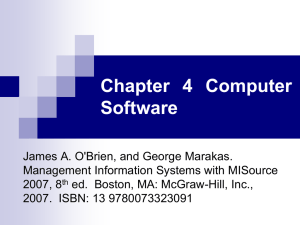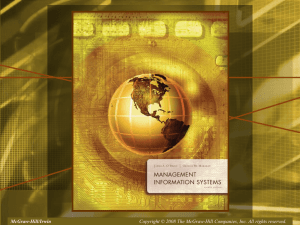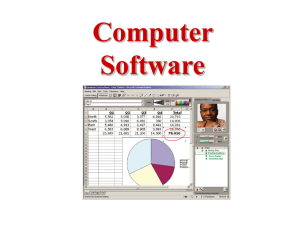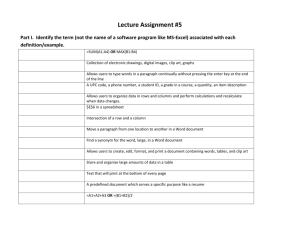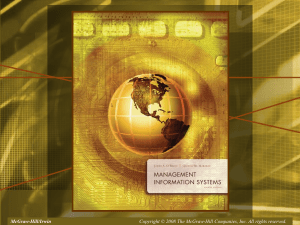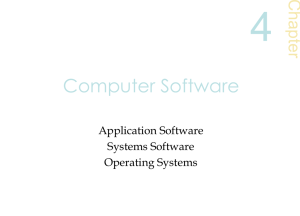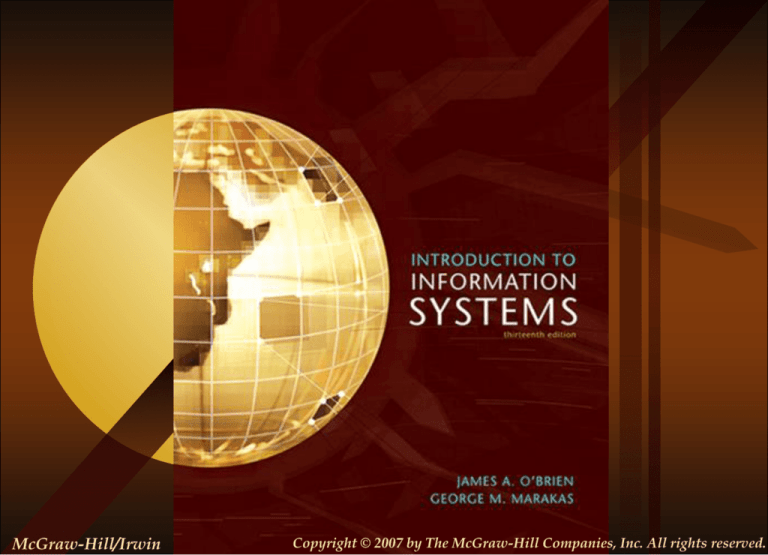
McGraw-Hill/Irwin
4-1
Copyright © 2007 by The McGraw-Hill Companies, Inc. All rights reserved.
Chapter
4
Computer Software
Application Software
Systems Software
Operating Systems
McGraw-Hill/Irwin
Copyright © 2007 by The McGraw-Hill Companies, Inc. All rights reserved.
Learning Objectives
1.
2.
3.
4.
4-3
Describe several important trends occurring in
computer software.
Give examples of major types of application and
system software.
Explain the purpose of several popular software
packages for end user productivity and
collaborative computing.
Define and describe the functions of an operating
system.
Learning Objectives
5.
4-4
Describe the main uses of computer programming
software, tools, and languages.
Case 1: Microsoft is looking at how
companies do business
Microsoft
has started focusing on different industries
and writing software products to support them
Examples,
financial services, communications,
government, education, automotive, retail and
hospitality, health care, manufacturing, media
Vertical segments: a specific industry
Accelerators: software add-ons aimed at business
processes common to a given industry
Software layers: software that serves the needs of a
broad base of companies in a particular sector inserted
into enterprise applications
4-5
Case Study Questions
1.
2.
4-6
A common phrase among IT professionals is “The
world views its data through Windows.” Why
does Microsoft dominate the desktop and
networked software market? Visit its website at
www.microsoft.com, and review its broad range of
software products and services to help with your
answer.
How successful will Microsoft be in competing
with software vendors who specialize in specific
market applications like health care, retail and
other specialty services? Why?
Case Study Questions
3.
4-7
Do you agree with Microsoft’s strategy to develop
industry-specific partners to capitalize on
opportunities in both large and small business
sectors? Is there an advantage or a disadvantage to
being one of Microsoft’s partners in this type of
relationship? Explain.
Real World Internet Activity
1.
Industry-specific software applications are
everywhere. Despite this, many industries still do
not have a wide variety of software applications to
meet their needs. Using the Internet,
See if you can find one example of an industry that
has a wide variety of vertical applications,
One industry that does not have a variety of software
solutions to choose from.
4-8
Real World Group Activity
2.
Using the industries who do not have a wide
variety of support applications that you found from
the first activity, in small groups,
4-9
Discuss what types of applications would be valuable to
your industries.
Why do you think the applications you came up with have
not been developed?
Types of software
4-10
Software types
Application
Performs
System
software
information processing tasks for end users
software
Manages
and supports operations of computer systems
and networks
4-11
Application software
General
purpose
Programs
that perform common information
processing jobs for end users
E.g., word processing, spreadsheet, etc.
Also called productivity packages
Application-specific
Programs
that support specific applications of end
users
E.g., electronic commerce, customer relationship
management, etc.
4-12
Software classifications
Classify
based on how it was developed
Custom software
Software
applications that are developed within an
organization for use by that organization
COTS
software
Commercial
Off-the-shelf (COTS)
Software developed with the intention of selling the
software in multiple copies
Why
would you choose Custom over COTS?
Why would you choose COTS over Custom?
4-13
Software Suites
4-14
Software Suites
Software
suites integrate software packages
Advantages:
Cost less than buying individual packages
All have a similar GUI
Work together well
Disadvantages
4-15
Features not used by all users
Take a lot of disk space
Integrated Packages
Integrated
Combine
packages
the functions of several programs into one
package
E.g., Microsoft Works, AppleWorks
Advantages:
Many functions for lower price and smaller disk space
Disadvantage
4-16
Limited functionality
Web Browser
Software
applications that support navigation
through the point-and-click resources of the Web
Surfing the web
Becoming a universal software platform for Internetbased applications
Microsoft Explorer, Netscape Navigator, Firefox,
Opera or Mozilla
4-17
E-mail, Instant Messaging and
Weblogs
E-mail
Software
to communicate by sending and receiving
messages and attachments via the Internet, intranet or
extranet
Instant
messaging (IM)
Receive
Weblog
A
electronic messages instantly
or blog
personal website in dated log format
Updated with new information about a subject or range
of subjects
4-18
Word processing and Desktop
publishing
Word
processing
Create,
edit, revise and print documents
E.g., Microsoft Word, Lotus WordPro and Corel
WordPerfect
Desktop
Publishing
Produce
printed materials that look professionally
published
E.g., Adobe PageMaker, Microsoft Publisher and
QuarkXPress
4-19
Electronic Spreadsheets and
Presentation Graphics
Electronic
Spreadsheets
Worksheet
of rows and columns
Used for calculations and charts
E.g., Lotus 1-2-3, Microsoft Excel, Corel QuattroPro
Presentation
Convert
Graphics
numeric data into graphics displays
Prepare multimedia presentations including graphics,
photos, animation, and video clips
E.g., Microsoft PowerPoint, Lotus Freelance, Corel
Presentations
4-20
Personal Information Manager and
Groupware
Personal
Information Manager (PIM)
Software
for end user productivity and collaboration
Store information about clients, schedules, manage
appointments, manage tasks
E.g., Lotus Organizer, Microsoft Outlook
Groupware
Software
that helps workgroups collaborate on group
assignments
E-mail, discussion groups, databases,
videoconferencing
E.g., Lotus Notes, Novell GroupWise, Microsoft
Exchange
4-21
Software alternatives
Outsourcing
development and maintenance of
software
Application service providers (ASPs)
Companies
that own, operate and maintain application
software and computer system resources
Use the application for a fee over the Internet
Pay-as-you-go
4-22
Software Licensing
All
software (COTS, ASP) is licensed
You don’t buy software: you buy a license to use the
software under the terms of the licensing agreement
Licensed to protect the vendor’s property rights
4-23
Case 2: Open-Source Software
Open-source
software
Also
referred to as free software
Software can be modified
Typically acquired with a license
License grant you the right to run the software, own the
source code, modify the source code and distribute
copies of the software
Free but have to pay for training, support,
documentation
Examples:
Linux, Apache Web server, Sendmail, Perl
scripting language
4-24
Case Study Questions
1.
2.
3.
4-25
What are the business benefits of adopting opensource software?
What are the risks associated with open-source
software? How can these risks be addressed?
Do you see open-source software eventually
replacing the current proprietary software model?
Explain your answer.
Real World Internet Activity
1.
A wide variety of organizations have been formed
to advance the open-source initiative. Using the
Internet,
See if you can find information on these open-source
advocate organizations.
A good place to start is www.opensource.org
4-26
Real World Group Activity
2.
Supporters as well as detractors of open-source
operating systems such as Linux are quite
passionate about their feelings. In small groups,
4-27
Discuss the advantages and disadvantages of open-source
applications.
If any of your classmates have experience with systems
such as Linux, ask them to explain their feelings and
experiences.
System software
Software
that manages and supports a computer
system
System management programs
Programs
that manage hardware, software, network,
and data resources
E.g., operating systems, network management
programs, database management systems, systems
utilities
Systems
development programs
Programs
programs
4-28
that help users develop information system
Operating System
Integrated
Manages
system of programs that
the operations of the CPU
Controls the input/output and storage resources and
activities of the computer system
Provides support services as computer executes
applications programs
4-29
Operating System basic functions
4-30
User Interface
Part
of the operating system that allows you to
communicate with it
Three main types:
Command-driven
Menu-driven
Graphical
4-31
user interfaces (GUI)
Resource management
Part
of operating system that manages the hardware
and networking resources of a computer system
Includes
CPU, memory, secondary storage device,
telecommunications, and input/output peripherals
Virtual
memory
Swapping
parts of programs and data between
memory and magnetic disks
4-32
File management
Part
of the operating system that controls the
creation, deletion, and access of files of data and
programs
4-33
Task Management
Part
of the operating system that manages the
accomplishment of computing tasks of the end users
Multitasking
Task
management approach that allows for several
tasks to be performed in a seemingly simultaneous
fashion
Assigns only one task to CPU but switches between tasks
so quickly looks like executing all programs at once
Also
4-34
called multiprogramming or time-sharing
Popular Operating Systems
4-35
Windows
GUI, multitasking, networking, multimedia
Microsoft’s operating system
Different versions manage servers
Unix
Multitasking, multiuser, network-managing
Portable – can run on mainframes, midrange and PCs
Linux
Low-cost, powerful reliable Unix-like operating system
Open-source
MAC OS X
Apple operating system for the iMac
GUI, multitasking, multimedia
Other types of system software
4-36
Other system software
Utilities
Miscellaneous
housekeeping functions
Example, Norton utilities includes data backup, virus
protection, data compression, etc.
Performance
monitors
Programs
that monitor and adjust computer system to
keep them running efficiently
Security
monitors
Programs
that monitor and control use of computer
systems to prevent unauthorized use of resources
4-37
Application servers
Provide
an interface between an operating system
and the application programs of users
Middleware
Software
that helps diverse software applications
exchange data and work together more efficiently
4-38
Programming Languages
4-39
Machine Languages
First-generation
languages
All program instructions had to be written using
binary codes unique to each computer
Programmers had to know the internal operations of
the specific type of CPU
4-40
Assembler Languages
Second-generation
languages
Symbols are used to represent operation codes and
storage locations
Need language translator programs to convert the
instructions into machine instructions
Used by
systems programmers (who program system
software)
4-41
High-Level Languages
Third-generation
languages
Instructions that use brief statements or arithmetic
expressions
Macroinstructions: each statement generates several
machine instructions when translated by compilers
or interpreters
Easier to learn than assembler
Machine independent
Less efficient than assembler
4-42
Fourth-Generation Languages
Variety
of programming languages that are
nonprocedural and conversational
Nonprocedural – users specify results they want
while computer determines the sequence of
instructions that will accomplish those results
Natural Language – very close to English or other
human language
4-43
Object-Oriented Languages
4-44
Combine data elements and
the procedures that will be
performed upon them into
Objects
E.g., an object could be data
about a bank account and the
procedures performed on it
such as interest calculations
Object-Oriented Languages
Most
widely used software development languages
today
Easier to use and more efficient for graphics-oriented
user interfaces
Reusable: can use an object from one application in
another application
E.g., Visual Basic, C++, Java
4-45
Web Languages
4-46
HTML
A page description language that creates hypertext
documents for the Web
XML
Describes the contents of Web pages by applying identifying
tags or contextual labels to the data in Web documents
Java
Object-oriented programming language that is simple, secure
and platform independent
Java applets can be executed on any computer
J2EE versus .Net
4-47
Web Services
Software
components
based on a framework of Web and object-oriented
standards and technologies
for using the Web
to electronically link the applications of different
users and different computing platforms
4-48
How web services work
Source: Adapted from Bala Iyer, Jim Freedman, Mark Gaynor and George Wyner, “Web Services: Enabling Dynamic Business
Networks,” Communications of the Association for Information Systems, Volume11, 2003, p. 543.
4-49
Language Translator Programs
Translate
instructions written in programming
languages into machine language
Assembler
translates
assembler language statements
Compiler
translates
high-level language statements
Interpreter
compiler
that translates and executes each statement in
a program one at a time
Java is interpreted
4-50
Programming Tools
Help
programmers identify and minimize errors
while they are programming
Graphical
Programming Interfaces
Programming Editors
Debuggers
CASE
A
tools
combination of many programming tools into a
single application with a common interface
Used in different stages of the systems development
process
4-51
Case 3: Amazon and eBay
New Face of Web Services
Amazon
provides access to some of its data and
website functionality
eBay opened up e-commerce software
Opened to programmers and any company
interested in e-commerce
4-52
Case Study Questions
1.
2.
3.
4-53
What are the purpose and business value of Web
services?
What are the benefits of Web services to Amazon,
eBay, and their developer partners?
What are the business challenges of Web services?
Visit the Web services websites of IBM
(www.ibm.com/solutions/webservices) and
Microsoft (www.microsoft.com/webservices) to
help with your answer.
Real World Internet Activity
1.
The concept of Web services and the opportunities
they provide are growing everyday. Using the
Internet,
4-54
See if you can find ways in which companies are
using Web services beyond those listed in the case.
Real World Group Activity
2.
Being able to integrate one organization’s website
with another’s poses some interesting questions of
privacy, intellectual property protection and
technical challenges. In small groups,
Discuss privacy, intellectual property protection and
technical challenges issues.
Do you think there is any risk associated with this
type of cooperation?
4-55


